The Correlation between Students' Preferences and English Achievement in Hybrid Learning during Covid-19 Pandemic
Keywords:
Hybrid learning; students’ preferences; students’ achievement; correlationAbstract
The objective of this study was to investigate the correlation between university students’ preferences and their English achievement in hybrid learning. Correlational research design was utilized in this research. The participants of this study were 77 students from three universities in Pekanbaru, Riau. Random sampling technique was applied in choosing the participants in this study. The researcher collected the data of this study through questionnaire and achievement test. Descriptive statistical analysis namely correlation and regression analysis were applying to analyze the quantitative data. The findings revealed that there was a significant correlation between students’ preferences on their English achievement in hybrid learning with p-value 0.000<0.05 and correlation coefficient was 0.723. This result was categorized as a high or strong correlation. In addition, regarding to the results of regression analysis, R square was 0.522 which mean the influence percentage of university students’ preferences to students’ English achievement was 52.2%. The conclusion of this study that there was a strong correlation between students’ preferences in hybrid learning and their English achievement during COVID-19 pandemic.
Downloads
References
Abed, T. B. B. (2021) Investigating EFL Students’ Preferences and Belief about Online vs. Face-to-face Learning at Birzeit University. Ricerche di Pedagogia e Didattica – Journal of Theories and Research in Education 16, 3.
Anabel, T.W.V., & Debora, C. S.(2022). Obtaining preferences from a hybrid learning system to promote English-speaking ability through focus group discussion. Journal of languages and language teaching. Vol. 10(2), 118-133.
Arikunto, Suharsimi .(2006). Prosedur Penelitian. Jakarta: PT. Rineka Cipta.
Bruffee, K. (1993). Collaborative Learning. Baltimore: The John Hopkins University Press.
Cahyadi, A., Hendryadi., Widyastuti, S., & Suryani. (2022). COVID-19, Emergency Remote Teaching Evaluation: The Caseof Indonesia. Springer Journal. Education and Information Technologies (7), 2165-2179.
Cheung, S. K. S., Fong, J., Fong, W., Wang, F. L., & Kwok, L. F. 2013. Hybrid Learning and Continuing Education: 6th International Conference. ICHL 2013. Toronto. ON. Canada.
Dhawan, S. (2020). Online Learning: A Panacea in the Time of COVID-19 Crisis. SAGE Journals, 5-22.
Direktorat Jenderal Pendidikan Tinggi, Kebudayaan, Riset dan Teknologi. Penyelenggaraan Pembelajaran Tatap Muka Tahun Akademik 2021/2022. Retrieved from: http://dikti.go.id/pengumuman/penyelenggaraan-pembelajaran-tatap-muka-tahun-akademik-2021-2022/
Dong, X. P & Yu, B. (2017). Research and Practice of Hybrid Teaching Model of Trinity. Eurasia Journal of Mathematics. Science and Technology Education, 13(8), pp.5589-5596.
Fowler, F.J. (2014). Survey Research Methods (V.Knight, Ed.; Fifth). SAGE Publication.
Goni, R. C., Muntuuntu, M., & Sanger, M. (2021). The Correlation between Students’ Interest and Academic Achievement in Learning English. E-Clue Journal of English, Culture, Language, Literature, and Education. Vol.9(1), 30-46.
Graham, C. R et al. (2003). Benefits and Challenges of Blended Learning Environments. In M.Khorow-Pour (Ed), Encyclopedia of Information Science and Technology I-V. Hershey, PA: Idea Group Inc.
Gruba, P., & Hinkelman, D. (2012). Blending Technologies in Second Language Classrooms. New York, NY: Palgrave macmillan.
Harmer, J. (2012). Essential Teacher Knowledge. Core Concepts in English Language Teaching. England: Pearson Educational Limited.
Hediansah, D., & Surjono, H. D. (2020). Hybrid learning dalam pembelajaran pendidikan jasmani sekolah dasar dan menengah umum maupun pendidikan olahraga perguruan tinggi. Prosiding SENOPATI.
Jee, R. Y and O’Connor, G. (2014). Evaluating the Impact of Blended Learning on Performance and Engagement of Second Language Learners. IJAC, 7(3) 12.
Kazu, Y., & Yalcin, C.K. 2022. The Effectiveness of Hybrid Learning on Academic Achievement: A Meta-Analysis Study. International Journal of Progressive Education. Vol.18(1), 259-265.
Klimova, B. F & Kacetl, J. 2015. Hybrid Learning and its Current Role in the Teaching of Foreign Languages. Elsevier, 477-481.
Ludico, M. G., Spauldin, D. T., & Voegtle, K. H. (2006). Methods in Educational Research: from Theory to Practice (1st ed.). Market Street, San Francisco: John Wiley & Sons, Inc. All Rights reserved.
Marsh, D. (2012). Blended Learning: Creating Learning Opportunities for Language Learners. Cambridge University Press.
Musdariah, A., Basri, M., & Jabu, B. (2021). The Impact of Hybrid Learning in Teaching English for Business Communication in Vocational Higher Education of Indonesia. International Journal of Humanities and Innovation, Vol.4, No.3, 104-110.
Muthuprasad, T., Aiswarya, S., Aditya, K. S., & Girish, K. J. (2021). Students’ Perception and Preference for Online Education in India during COVID-19 Pandemic. Social Sciences and Humanities. Elsevier.
Ng, W. (2015). Theories Underpinning Learning with Digital Technologies. In New Digital Technology in Education. Springer International Publishing, 73-94.
Poulova, P. & Simonova, I. (2012). Flexible E-Learning: Online Courses Tailored to Student’s Needs. Proceeding of the 9th International Scientific Conference on Distance Learning in Applied Informatics (DIVAI 2012), 251-260.
Pawan, F., Wicchart, K. A., Warren, A.N., & Park, J. (2016). Pedagogy and Practice for Online English Language Teacher Education. TESOL Press.
Roswani, S, Lubis, S, Risnawaty., & Ramadhan, A. (2021). Students’ Preferences on Online Learning in the New Normal Period of the COVID-19 Pandemic. Language Literacy: Journal of Linguistics, Literature and Language Teaching. Vol 5(2), 404-416.
Samsonov, P. 2021. Students’ Preferences after Taking Online, Face-to-face and Hybrid Course on Educational Technology: Findings and Practical Recommendations. IGI Global Publisher, 301-319.
Sharma, P., & Barrett, B. (2017). Blended Learning: Using Technology in and beyond the Language Classroom. Oxford, UK: Macmillan Education, 33-39.
Sukiman, Haningsih, S., & Rohmi, P. (2021). The Pattern of Hybrid Learning to Maintain Learning Effectiveness at the Higher Education Level Post COVID-19 Pandemic. European Journal or Educational Research. Vol.11 (1), 234-257.
Syam,.H., Basri, M., Abduh, A., Patak, A.A., & Rosmaladewi. (2019). Hybrid E-Learning in Industrial Revolution 4.0 for Indonesia Higher Education. International Journal on Advanced Science, Engineering and Information Technology, 9(4).
Qi, L, and Tian, A. (2011). Design and Application of Hybrid Learning Platform Based on Joomla. Eds. Advances in Computer Science and Education Applications, 549-556.
Virtic, M.P., Dolenc, K., & Sorgo, A. (2021). Changes in Online Distance Learning Behavior of University Students during the Coronavirus Diseases 2019 Outbreak, and Development of the Model of Forced Distance Online Learning Preferences. European Journal of Educational Research, 10(1), 393-411.
Wichadee, S. (2018). Significant Predictors for Effectiveness of Blended Learning in a Language Course. JALT CALL Journal; 14(1), 25-42.
Wahyuni, D. (2021). Salinan Keputusan Bersama Menteri Pendidikan dan Kebudayaan, Menteri Agama, Menteri Kesehatan, dan Menteri Dalam Negeri Republik Indonesia. Panduan Penyelenggaraan Pembelajaran dimasa Pandemi COVID-19. 30 Maret 2021.
Warman, L. A. D. (2021). The Effect of Google Classroom in Blended Learning on University Students’ English Ability. J-SHMIC: Journal of English for Academic, 8(1), 12-23.
Warman, L. A. D. (2022). Students’ Perception of the Use of Google Classroom in Flipped English Learning during COVID-19 Pandemic. Proceeding of TEFLIN ICOELT 2021. Atlantis Press, Vol.624, 158-169.
Yang, X. (2019). Application of Hybrid Teaching Method in English Teaching. Advances, Education and Humanities Research, Vol. 268. SOHE 2019. Atlantis Press.
Published
How to Cite
Issue
Section
This is an open-access article distributed under the terms of the Creative Commons Attribution-ShareAlike 4.0 International License which permits unrestricted use, distribution, and reproduction in any medium. Users are allowed to read, download, copy, distribute, search, or link to full-text articles in this journal without asking by giving appropriate credit, providing a link to the license, and indicating if changes were made. All of the remixes, transform, or build upon the material must distribute the contributions under the same license as the original.











